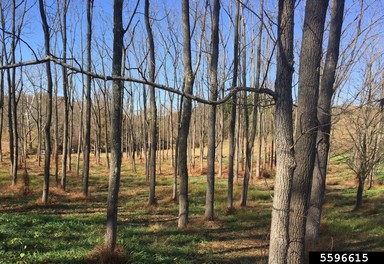Black Walnut: Legacy Timber Supply

Prized
Furniture and cabinet makers covet black walnut for its deep brown color, straight grain and relative hardness. No other North American species looks or behaves like it. Because of its straight grain and hardness, J. nigra is extremely stable. It shrinks and swells very little. Likewise, walnut properly cured, seldom warps or twists. These attributes make black walnut a top pick for high-end woodworkers. Native Americans and settlers alike competed with squirrels for the nut meats. Its strong nutty flavor goes a long way, especially in baked goods.
Although it only accounts for about 1% of sawlogs, it is the most valuable sawtimber species with stumpage prices around $1,500 per MBF.
Right Place for Black Walnut
Black walnut grows naturally from Grant County northeast to the easter edge of the Baraboo hills and northwest to somewhere near La Crosse. They grow in the deep neutral soils typical of those found in the “driftless”. These soils result from the large underlying limestone deposits.
J. nigra thrives in fire-dependent ecosystems because it requires plenty of sunlight. That is why black walnut grow among oak and hickory in savanna and open woodland communities. Black walnut cannot tolerate heavy shade so you will not find them in the cooler darker maple or pine forest environments.
The price of black walnut reflects it desirability and relative scarcity. Where J. nigra does not naturally occur in large stands, Wisconsin landowners are now cultivating black walnut in larger commercial groves.
Fire
The thick corky bark of black walnut trunks protect the tree from heat generated by low intensity fire. They are considered fire tolerant and are typically found growing in fire dependent ecosystems. Fire kills competing woody shrubs and tree species like maple that are adapted to a regime of fire. It recycles carbon and other elements quickly back into the soil improving soil fertility. Because large areas can be burned relatively easily, prescribed fire is an economical and efficient management tool.
J. nigra seedlings, however, lack protective bark and thus suffer “top kill” when burned. While the above ground portions of the tree are killed by heat, the tree quickly re-sprouts from its base following a fire. This can set back a young planting. It may also impact the quality of the stand as re-sprouted trees may not be as straight and well formed.
Mature plantations can benefit from low intensity prescribed fire. Understand that fire will damage young trees and impact regeneration. Thus growers usually opt for mowing or herbicide for managing weed and brush in their plantations.
Black Walnut Toxicity
Despite the beauty of its wood and tasty nut meat, black walnut trees are not always a welcome part of the landscape. Black walnut toxicity is a well known problem for homeowners and park mangers. The tree releases a toxic substance called juglone from its roots that prevents many plants from growing under or near them. Even after a walnut tree is cut down, juglone can persist due to remaining root fragments in the soil.
Legacy
You don’t plant black walnut to get rich; you plant it to make your grandchildren wealthy. It can make between three and four feet of growth in their first several years. That rate slows considerably as trees get older. It takes as least fifty years before this hardwood species is ready for harvest. More typically, landowners will harvest at closer to eighty years, with veneer trees grown for a century or more.
While this may seem much longer than species such as Jack pine, birch or fir, black walnut grows relatively fast for hardwood species. Growth rates of J. nigra are almost double that of other hardwood species and mortality is much lower. It accounts for 0.6% of all volume in the state but 1.1% of total growth and only 0.1% of mortality.
Assistance
There is an active statewide organization called the Wisconsin Walnut Council that holds field days each year. It is a chapter of the Walnut Council, a national organization with 800 members founded in 1970.
